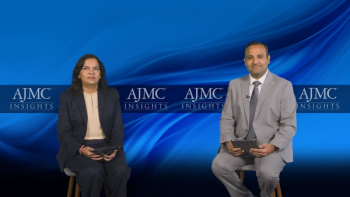
Experts discuss the unmet needs in desmoid tumor management, emphasizing personalized treatment, quality of life, and the importance of specialized care.

Experts discuss the unmet needs in desmoid tumor management, emphasizing personalized treatment, quality of life, and the importance of specialized care.

At ASH 2025, sonrotoclax demonstrated encouraging response rates and a favorable safety profile as a single-agent BCL2 inhibitor in heavily pretreated, largely refractory mantle cell lymphoma.

Explore the latest advancements in HER2-positive breast cancer treatments, highlighting the promising results of DESTINY-Breast trials for improved patient outcomes.

Experts discuss the challenges of diagnosing rare diseases and the potential role of AI in improving patient management and treatment outcomes.

Achieving equitable access to anti-fibrotic drugs requires multi-stakeholder collaboration, while the most critical unmet clinical need remains overcoming late and misdiagnosis through targeted education to ensure earlier therapy and better patient outcomes.

Explore the integration of Desmoid Tumor Working Group recommendations with NCCN guidelines and the importance of shared decision-making in patient care.

Following the clinical success of new agents like nerandomilast, the next critical steps for managing ILD involve dismantling financial and geographical barriers to access, and rigorously integrating comprehensive, multidisciplinary supportive care including pulmonary rehabilitation and comorbidity management.

Intravenous (IV) and subcutaneous (SC) formulations each play important roles in modern oncology care, with distinct strengths and limitations. IV administration offers established dosing precision, flexibility for complex regimens, and familiarity across oncology practices, but it is often associated with longer chair time, higher staffing demands, and increased use of infusion resources. In contrast, SC injections provide a more streamlined approach, with shorter administration times and reduced need for infusion infrastructure. Emerging evidence suggests that SC formulations can meaningfully decrease health care utilization, improve clinic efficiency, and enhance patient convenience without compromising clinical outcomes. For patients, SC delivery may translate into less time in the clinic and a more favorable treatment experience, while practices may benefit from improved throughput and optimized resource allocation. Together, these considerations highlight the growing value of SC formulations in evolving oncology care models.

Managed care organizations must prioritize dextromethorphan-bupropion based on sustained efficacy, improved remission rates, and long-term safety data to reduce costly treatment-resistant depression.

At ASH 2025, sonrotoclax demonstrated encouraging response rates and a favorable safety profile as a single-agent BCL2 inhibitor in heavily pretreated, largely refractory mantle cell lymphoma.

Discover how advancements in HER2-positive breast cancer treatment enhance patient outcomes through personalized therapies and innovative strategies for both early and metastatic stages.

New data suggests dextromethorphan plus bupropion may offer managed care cost containment by increasing remission rates in depression.

Zoe D. Draelos, MD, from Duke University, notes that clascoterone cream's unique sebum reduction mechanism provides effective, highly tolerable, and core acne treatment.

At ASH 2025, iMMagine-1 data showed that anito-cel has a favorable and durable safety profile with low rates of severe CRS, neurotoxicity, and infections.

Panelists discuss how evidence-based, patient-tailored guideline adherence enhances long-term schizophrenia outcomes.

Experts discuss the critical challenges in accessing innovative treatments for relapsed refractory multiple myeloma, emphasizing equity and education.

Exploration of pivotal data leading to the approvals of elranatamab and linvoseltamab, their efficacy, durability of response, and key safety considerations.


Explore the complexities of IgA nephropathy, its treatment advancements, and the challenges in early diagnosis and management in nephrology.

Panelists discuss how addressing social and structural barriers is essential to achieving equitable outcomes in schizophrenia care.

Updated iMMagine-1 data presented at ASH 2025 show that anito-cel delivers deep, durable responses in heavily pretreated multiple myeloma.

Andrew Yee, MD, introduces the discussion by reviewing treatment challenges, patient education, and decision-making in relapsed/refractory multiple myeloma.

Experts discuss the evolving role of bispecific antibodies in multiple myeloma, highlighting treatment advancements and strategies for optimal patient care.

The shift toward dual-targeting bispecifics and the imminent arrival of highly efficacious triple combinations could shift the follicular lymphoma treatment space.

Panelists discuss how the economic toll of poor LDL-C control demands workplace and systemwide prevention strategies.

Optimally positioning CD19-directed therapies in the follicular lymphoma treatment sequence requires consideration of both efficacy and the risk of sacrificing future options.

Sustained long-term safety data for tildrakizumab strengthens the positioning of IL-23 inhibitors as a preferred choice, especially for patients with comorbidities or a history of infection, and suggests their potential use in combination therapies for psoriatic arthritis.

Zachary Contreras of Sharp Health Plan highlighted strategies discussed at AMCP Nexus for improving timely access to Monoclonal Migraine Receptor (MMR) therapy through updated coverage pathways, specialist input, and real-time benefit checks.

Experts discuss dose reduction strategies and emerging therapies for desmoid tumors, emphasizing patient monitoring and quality of life improvements.

Zachary Contreras highlighted strategies discussed at AMCP Nexus for improving timely access to monoclonal migraine receptor (MMR) therapy through updated coverage pathways, specialist input, and real-time benefit checks.

259 Prospect Plains Rd, Bldg H
Cranbury, NJ 08512
© 2025 MJH Life Sciences®
All rights reserved.
